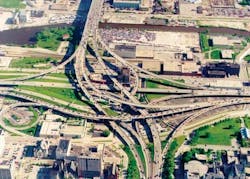Availability of Epoxy-Coated Rebar Keeps Project on schedule
The Marquette Interchange is an $810 million construction project in Milwaukee, Wis., with a 50-year history. Initial plans were presented in December 1952; the exchange was opened in December 1968. After 30 years of service, the Wisconsin DOT determined that it was time for reconstruction of the interchange, with the goal of building it better at a lower cost. It will also be reconfigured. Consisting of six phases, construction of the first phase began in April 2004. Completion of the entire project is scheduled for November 2008.
The project has many unique constraints. Many of the highways are not at grade, but are elevated or below grade. The project will make extensive use of bridges, retaining walls and short tunnels. In total, 152 bridges will be reconstructed close to the existing maximum height of 120 ft. Other project constraints include the reconfiguration within the existing footprint, reconstruction under traffic and an aggressive project schedule that requires construction during the winter season.
Owned by the Wisconsin Department of Transportation, the project was headed up by Milwaukee Transportation Partners and HNTB. The contractor on these phases was Walsh Construction Chicago. Toltec Steel Services, Kankakee, Ill., supplied all epoxy-coated and black reinforcing bars. Toltec also did the coating of the epoxy-coated steel reinforcing bars.
